Casanova’s piece “The Irish Paradigm” gave great insight into my reading of “Easter 1916” by W.B Yeats. Casanova asserts that Yeats found himself increasingly at odds with a growing Irish nationalism that distanced him further and further from the “center”, or English literary world, where he was gaining reputation (Casanova 307). Yeats’ perception of this growing conflict is echoed strongly it seems in “The Second Coming” and “Easter 1916”. Casanova’s use of the word “center” to describe England, is found in “The Second Coming” when Yeats states that “the center cannot hold”. There is a foreshadowing in this poem by Yeats’, signaling his understanding of the irrepressible Irish need for independence and rebellion against its center. Yet at the same time, this does not mean he is openly accepting of it. Hence his repeated description in “Easter 1916 ” of this ultimate struggle as “a terrible beauty”. Until reading Casanova’s piece which revealed Yeats’ growing dependency on English literary fame, I couldn’t initially understand Yeats’ tones of condemnation in both “Second Coming” and “Easter 1916”. The context really illuminated things for me.

The description in “Easter 1916” of growingly awkward interactions with people on Irish streets, alludes to the tensions that were arising and made everyone wary or skeptical of one another and their allegiances. His descriptions of men and women, transforming permanently into harsher versions of themselves, clearly points to his own skepticism about the effects of a nationalist and aggressively anti-English movement. Knowing what would later take place in the later 20th century, Yeats’ early skepticism is chillingly well founded.

Turning an eye to the “Proclamation of the Republic”, we see issues arise in some of the addresses made to the Irish people. The claim that the movement was “entitled to and hereby claims” the participation of the Irish people, is unsettling in its forcefulness. The secondary claim that the movement would disregard any religious or cultural “differences” introduced by past alien governments (England), is clearly one which would later be broken (Clarke et. al, 598).

I felt that reading the Proclamation coupled with Casanova’s piece, really allowed me to understand Yeats’ controversial stance on the matter. It is tragic, as one can see from the Yeats’ exhibition that he was a self professed proud Irishman and nationalist. One can see this in his revival of Ireland’s artistic cultural heritage and folklore. However, as he mentions, the center could not hold, and remaining moderate became increasingly impossible. I guess an interesting question to ask, would be do you think Yeats’ did lose some of his Irish identity by belonging to two worlds? Do you think his work was a way of asserting his pride of nationality, when others may have been skeptical?



